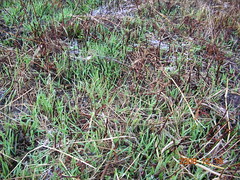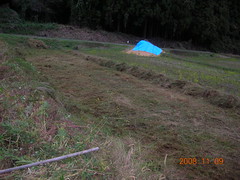This is a view of the fields from the roadside. You may be able to see some green mixed in with the dried out grass. Some of it is wheat, and some of it is other.
Wednesday, December 17, 2008
december wheat
This is a view of the wheat sprouting in our rice field. It looks really heathy and lush in this spot, but in others there isn't that much growth. I'm not sure why.
Sunday, December 07, 2008
1% Increase in Local Food Self-Sufficiency Would Bring 19 Billion Yen Annual Gain | Japan for Sustainability
1% Increase in Local Food Self-Sufficiency Would Bring 19 Billion Yen Annual Gain | Japan for Sustainability
An increase of sustainability sounds great, but if it comes through a greater dosing of the earth with petroleum or splicing in genes from somewhere, I'd say we should rely on the declining birthrate to lower population. That should bring about the same effect.
An increase of sustainability sounds great, but if it comes through a greater dosing of the earth with petroleum or splicing in genes from somewhere, I'd say we should rely on the declining birthrate to lower population. That should bring about the same effect.
Saturday, November 15, 2008
rain after seeding
Today and yesterday we have had some rain, so the seeds aren't going to get dried out.
Thursday, November 13, 2008
wheat planted
Yesterday I got the fields all ready and the wheat all planted. The field was mostly covered in grass, unfortunately not rice stubble as was planned, so I had to cut the grass and move it off the field. My children and I broadcast the seed by hand and then covered it with the grass that we had moved off to the margins of the field.
We planted "Ayahikari" variety wheat, with 30 kilograms of seed for all four fields with the following amounts for each field, moving downhill. 7.8 kilos, 9.5, 9.5, and 3.2.
The most significant threat to the crop will come from wild pigs who may gobble up the seed before it sprouts. Fungus and other disease may be a problem, but nothing really compared to the pig issue.
We planted "Ayahikari" variety wheat, with 30 kilograms of seed for all four fields with the following amounts for each field, moving downhill. 7.8 kilos, 9.5, 9.5, and 3.2.
The most significant threat to the crop will come from wild pigs who may gobble up the seed before it sprouts. Fungus and other disease may be a problem, but nothing really compared to the pig issue.
Monday, November 10, 2008
cut and stack grass
Spent 3 hours in the rice fields today, cutting grass and stacking it. Found that since the grass is all laying one direction you can roll it into a pile neatly at the end of the field. Works great.
Tomorrow some of the guys are coming around with the Biodynamic preparations. I think they will use "500," which is a concoction of cow manure that has been placed in a cow horn and left by the bank of a river over the winter. There is so little of the substance used that if there is any effect, it is the positive ministrations applied to the field rather any results any of the substances may have.
Tomorrow some of the guys are coming around with the Biodynamic preparations. I think they will use "500," which is a concoction of cow manure that has been placed in a cow horn and left by the bank of a river over the winter. There is so little of the substance used that if there is any effect, it is the positive ministrations applied to the field rather any results any of the substances may have.
Sunday, November 09, 2008
wheat plant
We are getting around to planting wheat. We broadcast the wheat sead and cut the weeds on top of them. The weed cover was so thick that we moved most of it off to the sides. This was probably a mistake, and will first cut and remove weeds, broadcast the seed, and then cover the seed with enough grass to discourage birds.
Monday, August 18, 2008
Masanobu Fukuoka moves on
Masanobu Fukuoka, author of "The One Straw Revolution," the book that I would rank as the most influential book of the 21st century (because it is my ranking and a book I didn`t meet until recently), moved on Saturday.
Thanks for the inspiration, Masanobu!
Thanks for the inspiration, Masanobu!
Wednesday, January 16, 2008
Japan: Government plans low-cost rice straw to biofuel production process
Kind of an interesting idea, but the idea that straw would be free is kind of strange. The only reason there is so much straw to begin with is that Japanese agriculture is so petroleum-dependent in the first place. No one has to worry about returning the straw nutrients to the soil, because petroleum-based fertilizers will keep the system in balance. There is no way that, given current farming practice, there would be anything like a sustainable volume of biofuel. There would instead be a continuous drain of nutrients from the soil that would eventually lead to sterile farm land.
Why don't they work instead on ending their dependence on oil?
Automotive World - Japan: Government plans low-cost rice straw to biofuel production process
Why don't they work instead on ending their dependence on oil?
Automotive World - Japan: Government plans low-cost rice straw to biofuel production process
Monday, January 14, 2008
tractor

Although I plan to plant rice without cultivation, I was offered a small tractor, a "kounki" (耕うン機)in Japanese. It isn't a riding tractor, but one you walk behind. One of the reasons that I am going to plant without cultivation, aside from Fukuoka's proscription, is that I don't have enough money to buy farm equipment. Since I got this one for free, I gratefully accepted it. One of the farmers I'm learning from, a student of Fukuoka's for some years, cultivates to a very shallow depth, and then plants. He does it so he can cover over the seeds better than just using straw, because he has a problem with birds eating his seeds. I may try one field cultivated, and the other one not and see how it goes, especially since this year I won't have the advantage of being able to cover the seeds with wheat straw since this is my first year of planting.
The kounki that I got is also nice because it's diesel, so if petroleum goes the way of the dodo or just gets too expensive to use, I may be able to switch to biodiesel.
Subscribe to:
Posts (Atom)


